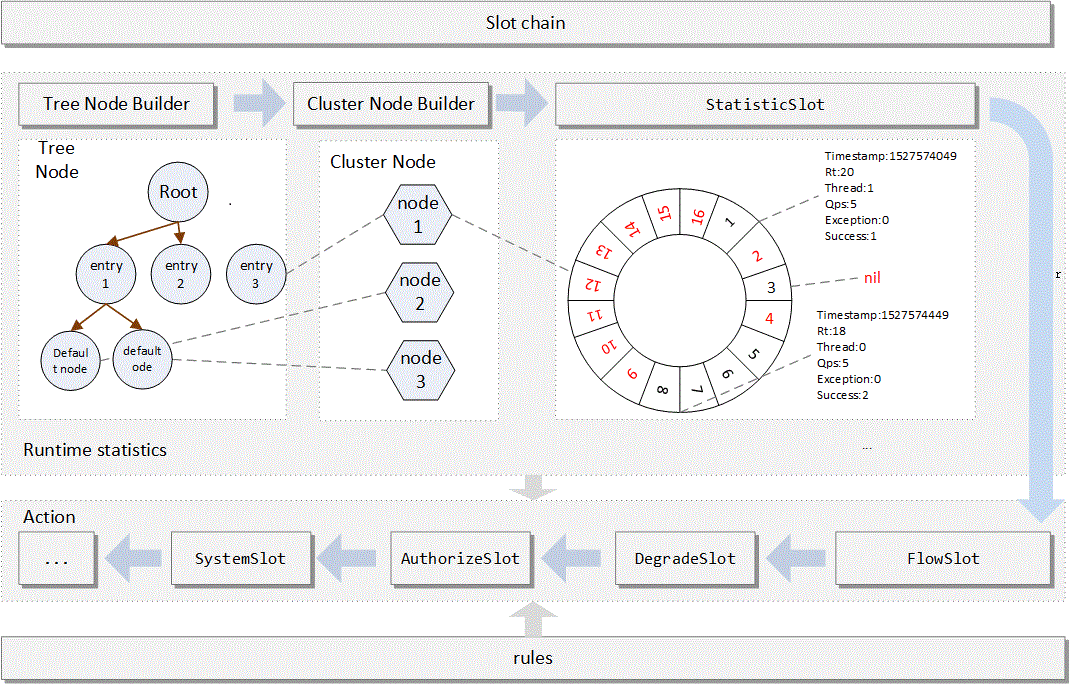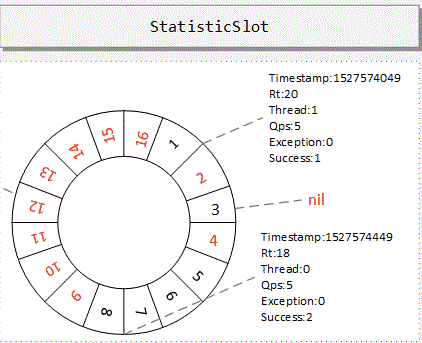您好,登錄后才能下訂單哦!
您好,登錄后才能下訂單哦!
這篇文章主要介紹“Alibaba Sentinel LeapArray源碼分析”,在日常操作中,相信很多人在Alibaba Sentinel LeapArray源碼分析問題上存在疑惑,小編查閱了各式資料,整理出簡單好用的操作方法,希望對大家解答”Alibaba Sentinel LeapArray源碼分析”的疑惑有所幫助!接下來,請跟著小編一起來學習吧!
最近在使用Alibaba Sentinel來做服務的限流、熔斷和降級。一直有一個比較好奇的點,Sentinel是如果做到高效的數據統計的。通過官方文檔介紹:
StatisticSlot: 則用于記錄、統計不同緯度的 runtime 指標監控信息;(做實時統計)
Sentinel 底層采用高性能的滑動窗口數據結構 LeapArray來統計實時的秒級指標數據,可以很好地支撐寫多于讀的高并發場景。
由此可以發現Sentinel使用了滑動窗口算法來做數據統計,并且具體實現是在LeapArray類中。
Sentinel 總體的框架如下: 
通過架構圖我們可以看到StatisticSlot中的LeapArray采用了一個環性數組的數據結構,這個和一致性hash算法的圖類似,如圖:

在這個結構中,每一個下標位就代表一個滑動窗口,至于這個窗口是怎么滑動的我們可以結合原來看。
StatisticSlot作為統計的入口,在其entry()方法中我們可以看到StatisticSlot會使用StatisticNode,然后StatisticNode回去引用ArrayMetric,最終使用LeapArray。
public WindowWrap<T> currentWindow(long timeMillis) {
if (timeMillis < 0) {
return null;
}
// 根據當前時間計算出當前時間屬于那個滑動窗口的數組下標
int idx = calculateTimeIdx(timeMillis);
// 根據當前時間計算出當前滑動窗口的開始時間
long windowStart = calculateWindowStart(timeMillis);
/*
* 根據下腳標在環形數組中獲取滑動窗口(桶)
*
* (1) 如果桶不存在則創建新的桶,并通過CAS將新桶賦值到數組下標位。
* (2) 如果獲取到的桶不為空,并且桶的開始時間等于剛剛算出來的時間,那么返回當前獲取到的桶。
* (3) 如果獲取到的桶不為空,并且桶的開始時間小于剛剛算出來的開始時間,那么說明這個桶是上一圈用過的桶,重置當前桶
* (4) 如果獲取到的桶不為空,并且桶的開始時間大于剛剛算出來的開始時間,理論上不應該出現這種情況。
*/
while (true) {
WindowWrap<T> old = array.get(idx);
if (old == null) {
/*
* B0 B1 B2 NULL B4
* ||_______|_______|_______|_______|_______||___
* 200 400 600 800 1000 1200 timestamp
* ^
* time=888
* bucket is empty, so create new and update
*
* If the old bucket is absent, then we create a new bucket at {@code windowStart},
* then try to update circular array via a CAS operation. Only one thread can
* succeed to update, while other threads yield its time slice.
*/
WindowWrap<T> window = new WindowWrap<T>(windowLengthInMs, windowStart, newEmptyBucket(timeMillis));
if (array.compareAndSet(idx, null, window)) {
// Successfully updated, return the created bucket.
return window;
} else {
// Contention failed, the thread will yield its time slice to wait for bucket available.
Thread.yield();
}
} else if (windowStart == old.windowStart()) {
/*
* B0 B1 B2 B3 B4
* ||_______|_______|_______|_______|_______||___
* 200 400 600 800 1000 1200 timestamp
* ^
* time=888
* startTime of Bucket 3: 800, so it's up-to-date
*
* If current {@code windowStart} is equal to the start timestamp of old bucket,
* that means the time is within the bucket, so directly return the bucket.
*/
return old;
} else if (windowStart > old.windowStart()) {
/*
* (old)
* B0 B1 B2 NULL B4
* |_______||_______|_______|_______|_______|_______||___
* ... 1200 1400 1600 1800 2000 2200 timestamp
* ^
* time=1676
* startTime of Bucket 2: 400, deprecated, should be reset
*
* If the start timestamp of old bucket is behind provided time, that means
* the bucket is deprecated. We have to reset the bucket to current {@code windowStart}.
* Note that the reset and clean-up operations are hard to be atomic,
* so we need a update lock to guarantee the correctness of bucket update.
*
* The update lock is conditional (tiny scope) and will take effect only when
* bucket is deprecated, so in most cases it won't lead to performance loss.
*/
if (updateLock.tryLock()) {
try {
// Successfully get the update lock, now we reset the bucket.
return resetWindowTo(old, windowStart);
} finally {
updateLock.unlock();
}
} else {
// Contention failed, the thread will yield its time slice to wait for bucket available.
Thread.yield();
}
} else if (windowStart < old.windowStart()) {
// Should not go through here, as the provided time is already behind.
return new WindowWrap<T>(windowLengthInMs, windowStart, newEmptyBucket(timeMillis));
}
}
}根據下腳標在環形數組中獲取滑動窗口(桶)的規則:
(1) 如果桶不存在則創建新的桶,并通過CAS將新桶賦值到數組下標位。
(2) 如果獲取到的桶不為空,并且桶的開始時間等于剛剛算出來的時間,那么返回當前獲取到的桶。
(3) 如果獲取到的桶不為空,并且桶的開始時間小于剛剛算出來的開始時間,那么說明這個桶是上一圈用過的桶,重置當前桶,并返回。
(4) 如果獲取到的桶不為空,并且桶的開始時間大于剛剛算出來的開始時間,理論上不應該出現這種情況。
這里有一個比較值得學習的地方是:
對并發的控制:當一個新桶的創建直接是使用的CAS的原子操作來保證并發;但是重置一個桶的時候因為很難保證其原子操作(1. 需要重置多個值;2. 重置方法是一個抽象方法,需要子類去做實現),所以直接使用一個ReentrantLock鎖來做并發控制。
對Thread.yield();方法的使用,這個方法主要的作用是交出CPU的執行權,并重新競爭CPU執行權。這個方法再我們業務代碼中其實很少用到。
通過上面這個方法我們可以看到我們是如果根據當前時間獲取到一個桶的(滑動窗口)。但是如何實現滑動效果的呢?實現滑動效果主要看上面那個方法的如何找到桶的下標和如何更加當前時間找到當前桶的開始時間,如下:
// 根據當前時間計算出當前時間屬于那個滑動窗口的數組下標 int idx = calculateTimeIdx(timeMillis); // 根據當前時間計算出當前滑動窗口的開始時間 long windowStart = calculateWindowStart(timeMillis);
// 根據當前時間計算出當前時間屬于那個滑動窗口的數組下標
private int calculateTimeIdx(/*@Valid*/ long timeMillis) {
// 利用除法取整原則,保證了一秒內的所有時間搓得到的timeId是相等的
long timeId = timeMillis / windowLengthInMs;
// 利用求余運算原則,保證一秒內獲取到的桶的下標位是一致的
return (int) (timeId % array.length());
}
// 根據當前時間計算出當前滑動窗口的開始時間
protected long calculateWindowStart(/*@Valid*/ long timeMillis) {
// 利用求余運算原則,保證一秒內獲取到的桶的開始時間是一致的
// 100 - 100 % 10 = 100 - 0 = 100
// 101 - 101 % 10 = 101 - 1 = 100
// 102 - 102 % 10 = 102 - 2 = 100
return timeMillis - timeMillis % windowLengthInMs;
}timeMillis:表示當前時間的時間戳
windowLengthInMs:表示一個滑動窗口的時間長度,根據源碼來看是1000ms即一個滑動窗口統計1秒內的數據。
這兩個方法巧妙的利用了除法取整和求余原則實現了窗口的滑動。通過最上面的結構圖我們可以發現滑動窗口會根據時間戳順時針旋轉。
桶的數量就決定了滑動窗口的統計時長,根據源碼來看是60個桶,即一個統計1分鐘內的數據。
內部是利用并發工具類LongAdder的特性來實現的高效的數據的統計。
到此,關于“Alibaba Sentinel LeapArray源碼分析”的學習就結束了,希望能夠解決大家的疑惑。理論與實踐的搭配能更好的幫助大家學習,快去試試吧!若想繼續學習更多相關知識,請繼續關注億速云網站,小編會繼續努力為大家帶來更多實用的文章!
免責聲明:本站發布的內容(圖片、視頻和文字)以原創、轉載和分享為主,文章觀點不代表本網站立場,如果涉及侵權請聯系站長郵箱:is@yisu.com進行舉報,并提供相關證據,一經查實,將立刻刪除涉嫌侵權內容。